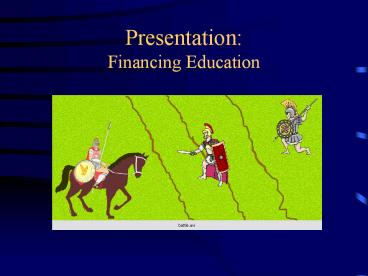Financing%20Education - PowerPoint PPT Presentation
Title:
Financing%20Education
Description:
Presentation: Financing Education – PowerPoint PPT presentation
Number of Views:305
Avg rating:3.0/5.0
Title: Financing%20Education
1
PresentationFinancing Education
2
Financing Education
- How Iowas Taxpayers Pay for Public Education
3
The Iowa State Budget(Receipts)
4
The Iowa State Budget(Expenditures)
5
Iowa Department of Education(Funding Sources
Comparison)
6
Where Does the MoneyCome From?
7
What Does the Money Go To?
8
Property Taxes
- Property taxes are assessed against the
adjusted-equalized value of real property
expressed per 1,000 in valuations. - For a 100,000 home in Davenport, the initial
school tax will be 850.74 - 296.20 is assessed as a base-line
- 554.54 is assessed to complete funding of the
districts educational budget (last 12.5)
9
Iowa Income Tax
- Tax on estimated income of 50,00050,000 x .05
2,500 - Income Tax used for Education.42 (Tax) x .57
(SFA) 242,500 x .24 600 - 7th Cent Sales Tax on estimatedexpendable
income25,000 x .01 250
10
Insidious Taxes
- Determining the actual cost of education is not
possible without a detailed accounting for all
monies involved. - EDUC tax on gas heat ??.??
- EDUC tax on gasoline ??.??
- Tax Incremental Financing ??.??TIF
- What else? ??.??
11
Iowa Education TaxesBased on a projected income
of 50,000 100,000 property valuation
- Property Tax 850.74
- Community College Tax(assessed on 100,000
property valuation) 33.08 - Personal Income Tax 600.00
- 7th Cent Sales Tax 250.00
- Insidious Taxes ???.??
- Total 1733.82
12
Taxation Applied to Education
13
The Cost to You
- The average Iowa household pays 1,733.82 for
education based on - Projected household income of 50,000
- Personal property valuation of 100,000
- When you become a property-owning taxpayer, you
will owe a similar amount each year. (Ask me
about taxation surcharges to renters.) - Are you mad yet?
14
Per Pupil Expenditure (1998-1999)
- National Average 6,232
- State of Iowa - 5,583
- Difference 649
- Cost per household5,583 x 2.3
12,841
15
The Bottom Line
- Cost per household 12,841
- Household contribution - 1,734
- Deficit per household 11,107
- Who pays the difference?
16
Who Pays the Difference?
- I do.
- Everyone who owns a home and does not have
children in public school - the Elderly (your grandparents)
- Empty Nesters (your parents)
- single persons (your brothers sisters)
- childless couples (people that you know)
- Agriculture assessed at 1.7 x residential rate
- Business assessed at 1.8 x residential rate
17
The Graying of Iowa Public Education
Enrollment Trends
18
What Does the Future Hold?
- Initially, more people will be paying for fewer
students, reducing the average cost. - If you do not like the methods that the State of
Iowa uses to pay for public education, it may not
matter. Why? - In the future, there may not be anyone left to
pay for public education, and the State of Iowa
will have to find other methods.
19
Iowas Impending Future
- Iowa is facing a 3.2 shortfall in revenue at a
minimum. Why? - Proposed changes to State Foundation Aid
- reduces mandated 5.40 assessment of taxable
valuation by half - eliminates local option sales taxes
- What would be the result?
20
Proposed Change to Iowas Taxation
21
References
Good news about our public schools. (2001,
January) National education association.
http//www.nea.org/publiced/goodnews/ Obradovich,
K. (2001, March 14). Panel OKs sales tax for
schools. Quad-City Times. p. A1. Scott County,
Iowa. (2000). Scott county tax levies.
Pamphlet. State of Iowa. (2000). Annual condition
of education report (FY 1999). Retrieved
February 22, 2001 from the World Wide Web
http//www.state.ia.us/educate/publications/fin
ance.pdf State of Iowa. (2000). Citizens report.
Retrieved February 22, 2001 from the World Wide
Web http//www.state.ia.us/governor/agenda/2000/
CITIZENS/REPORT.pdf Sate of Iowa. (1999). Final
Report of the task force to study Iowa's system
of state and local taxation. Retrieved March 7,
2001 from the World Wide Web
http//www.legis.state.ia.us/GA/77GA/Interim/1998/
comminfo/iatax/final.htm State of Iowa. (2000).
House file 1. Retrieved March 6, 2001 from the
World Wide Web http//www.state.ia.us/governme
nt/drf/taxlaw/HF1.html
22
References (Cont.)
State of Iowa. (2000). Legislative guide to basic
Iowa education finance. Retrieved March 9, 2001
from World Wide Web http//www.legis.state.ia
.us/Central/LSB/Guides/edfin.htm State of Iowa.
(2001, February). Monthly Revenue Report.
Retrieved April 20, 2001 from the World Wide
Web http//www.state.ia.us/government/dom/0
1-02.doc State of Iowa. (1997). Task force to
study Iowa's system of state and local
taxation. Retrieved March 9, 2001 from World
Wide Web http//www.legis.state.ia.us/GA/77GA/
Interim/1997/comminfo/iatax/ mn971008.htm State
of Iowa. (2000). Tax incremental financing (TIF).
Retrieved March 9, 2001 from the World Wide
Web http//www.smart.state.ia.us/financial.
htmtif Teacher's salary. (2001, January 16).
American association for employment in
education. Retrieved March 6, 2001 from World
Wide Web http//www.ub-careers.buffalo.edu/aaee/
salary.shtml































